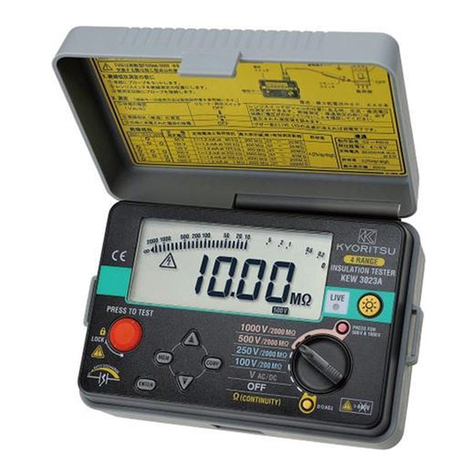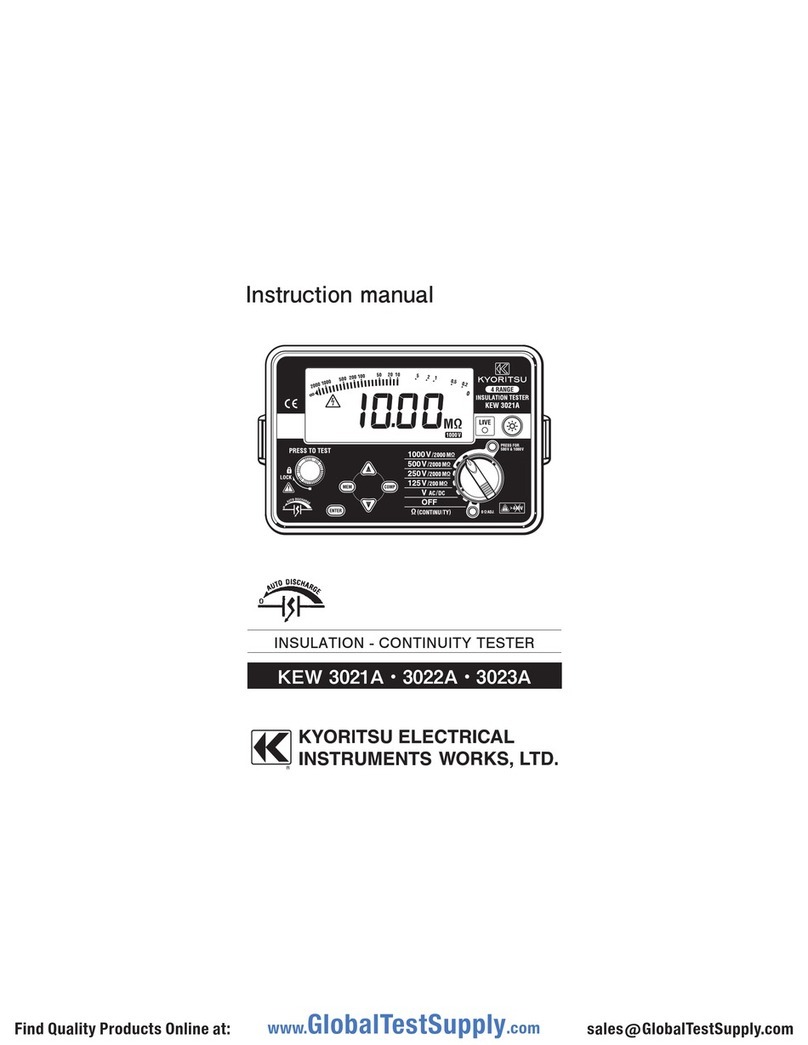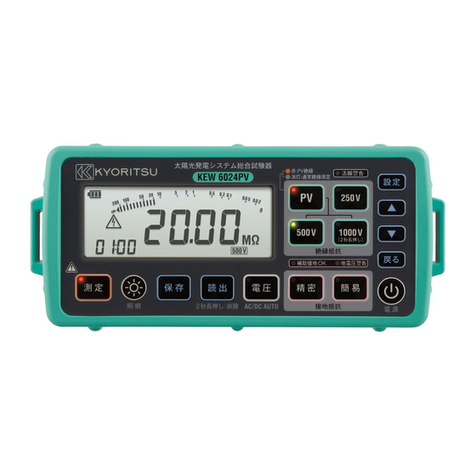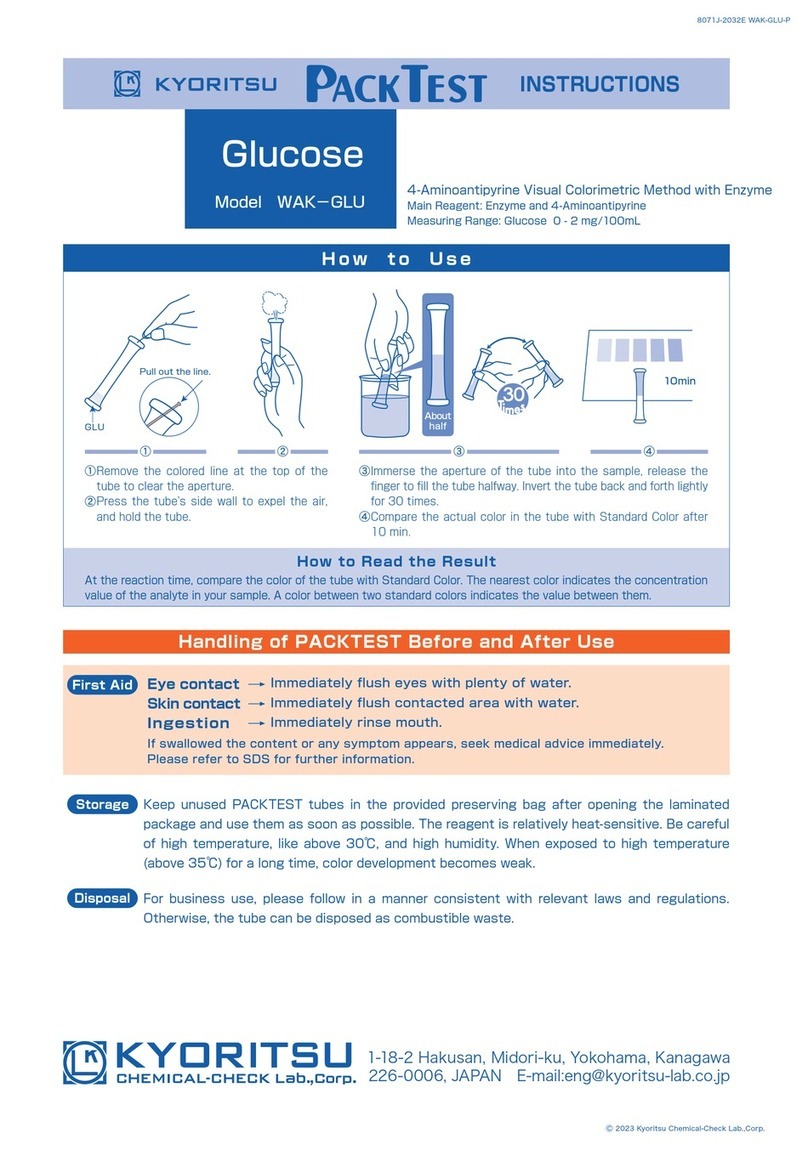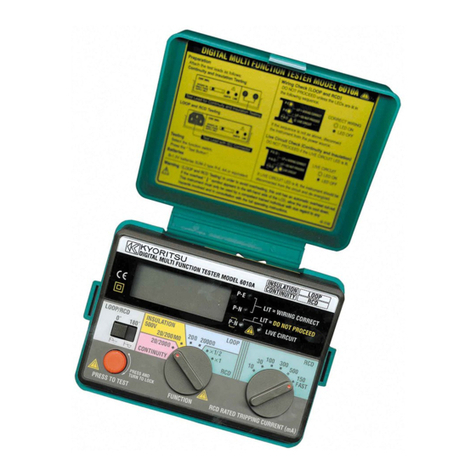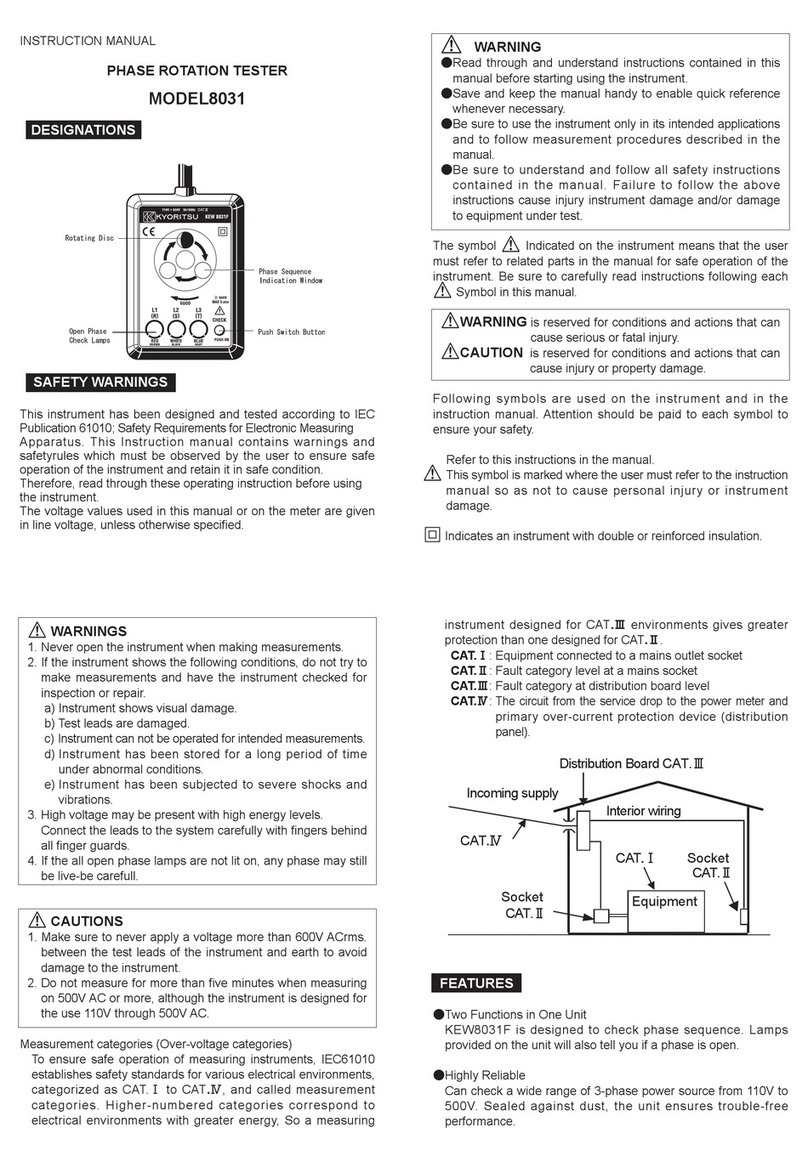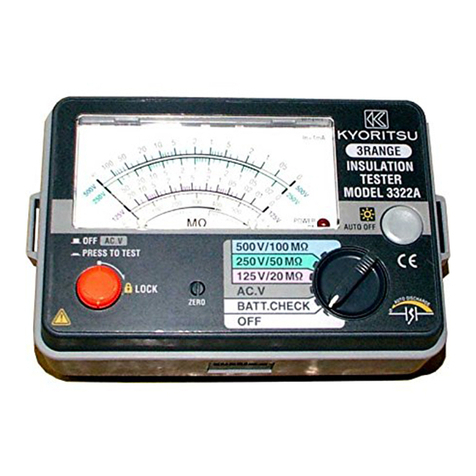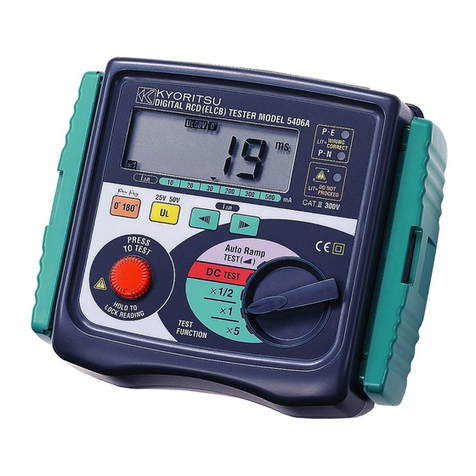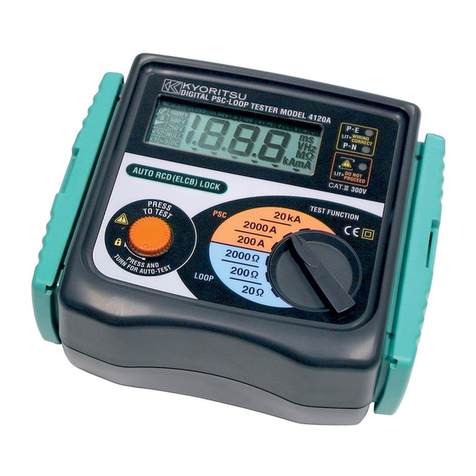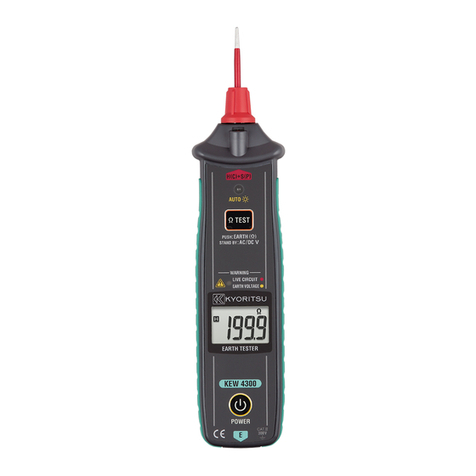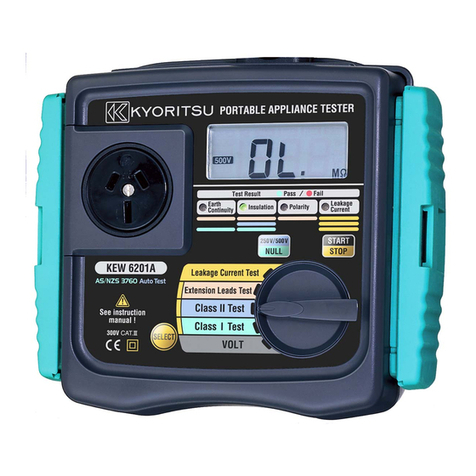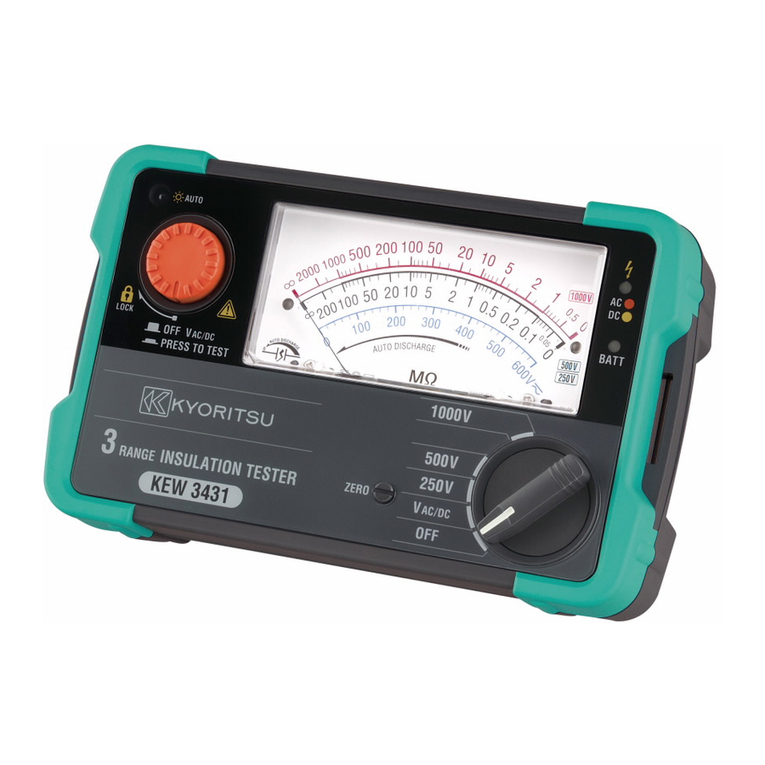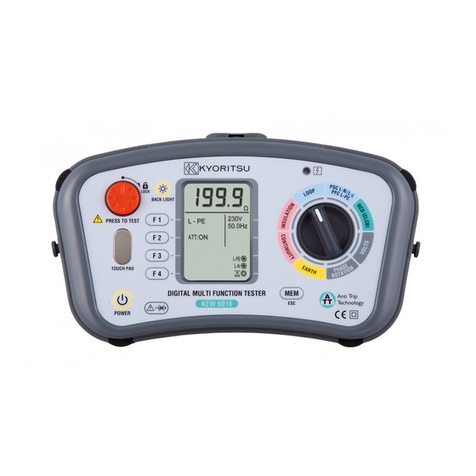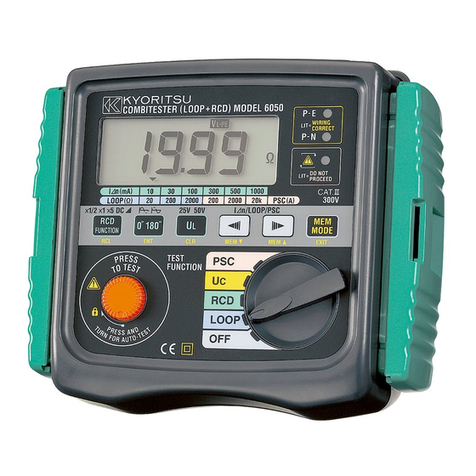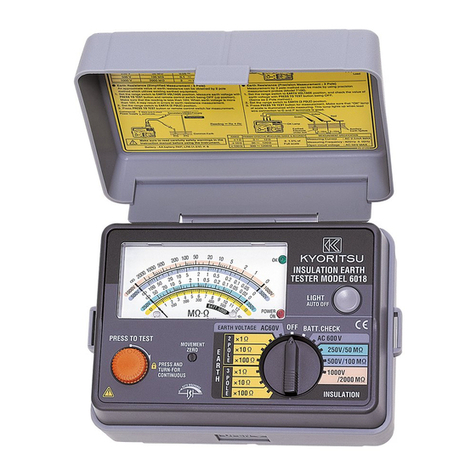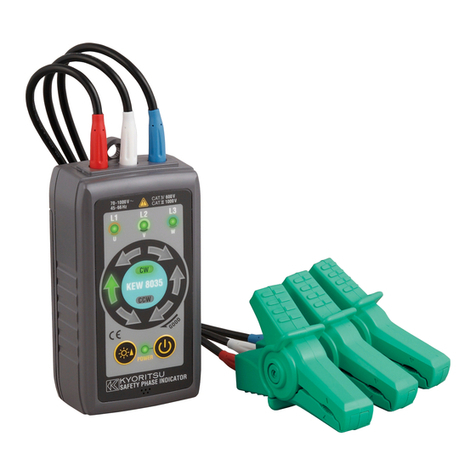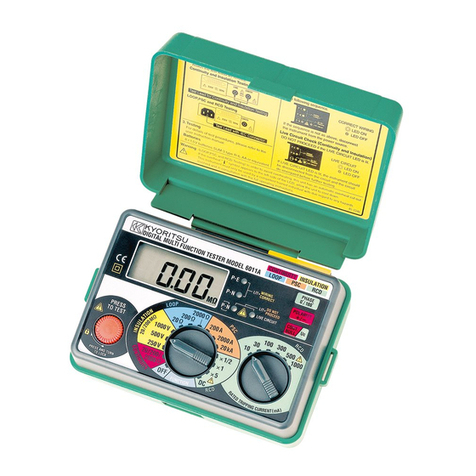ANALOGUE INSULATION TESTERS
3165
MODEL
3166
INSTRUCTION MANUAL 1. Always make sure to insert the plug of test leads fully into the terminal
of the instrument.
2. Never exceed the maximum allowable input of any measuring range
when making measurement.
3. Make sure to never apply a voltage more than 600V AC or DC between
the terminal of the instrument and earth.
4. Never try to operate the instrument in an explosive atmosphere ( i. e.
in the presence of flammable gases or fumes, vapor or dust).
5. Always inspect the instrument, test leads and accessories for any sign
of damage or abnormality before every use. If abnormal conditions
exist (e. g. broken test leads, cracked enclosure of the instrument), do
not try to make measurements.
6. Do not push the test button or lock it down while connecting test leads.
7. Do not touch the circuit under test during insulation testing.
8. Make sure to remove the test lead from the instrument and turn the
power off before opening the battery compartment cover for battery
replacement.
9. Always turn the power off after use.
10. Do not expose the instrument to the direct sun, dew fall, or extreme
temperatures.
11. Do not expose the instrument to a temperature of more than 50℃.
12. Calibration and repair of any instrument should only be performed by
qualified and trained service technicians.
13. Do not install substitute parts or perform any unauthorized
modification of the instrument. Return the instrument to your
distributor for service and repair to ensure that safety features are
maintained.
14. The instrument must be used by a competent, trained person and
operated in strict accordance with the instructions. KYORITSU
will not accept liability for any damage or injury caused by misuse
or noncompliance with the instructions or safety procedures. It is
essential to read and understand the safety rules contained in the
instructions. They must be observed when using the instrument.
2. Features
●AC voltage measurement can be made without depressing the test
button.
●Battery check facility.
●Uses only 4×1.5V battery type R6, AA or equivalent.
3. Specifications
●Measuring ranges accuracy(at 23±5℃, relative humidity 45-75%)
Insulation resistance ranges:
MODEL 3165 MODEL 3166
Test voltage
500V 1000V
Measuring range
1000MΩ2000MΩ
Mid-scale value
20MΩ50MΩ
Output voltage on
open circuit Rated test voltage +20%-0%
Output short
circuit current 230μA max 550μA max
Primary Effective
Measuring Range
1~500MΩ2~1000MΩ
Accuracy
±5% of indicated value at primary effective
measuring range
±0.7% of scale length at 0 and ∞
±10% of indicated value at other measuring range
AC Voltage Warning:
Warning range 0-600V AC
Accuracy ± 3%of scale length
Power supply 4×1.5V battery type SUM-3,R6,AA or equivalent
Overload protection Insulation Resistance Ranges
Model 3165: 600V (DC+ACp-p) for 10 seconds
Model 3166:1200V (DC+ACp-p) for 10 seconds
AC Voltage Range
720V (DC+ACp-p) for 10 seconds
Operating temperature & humidity
0-40℃, relative humidity up to 85%
Storage temperature & humidity
-10-50℃, relative humidity up to 75%
Withstand voltage 3700V AC for one minute between electrical
circuit and housing case
Insulation resistance More than 50MΩat 1000V between electrical
circuit and housing case
Dimensions 90(L)×137(W)×40(D)mm
Weight 330g
Accessories Test leads Model 7025(1 set)
Pouch for test leads (1 piece)
Shoulder strap (1 piece)
R6 batteries (4 pieces)
Instruction manual (1 copy)
4. Operation
4-1 Preparation for testing
(1)Mechanical zero adjustment
Without pressing the Test button, check that the pointer lines up with
1. Safety Precautions
●This instruction manual contains warnings and safety rules that must
be observed by the user to ensure safe operation of the instrument and
retain it in safe condition. Therefore, read these operating instructions
thoroughly and completely before using the instrument.
●The symbol #on the instrument means that the user must refer to
the relevant section of this instruction manual for safe operation of the
instrument.
●Pay particular attention to all WARNINGS and CAUTIONS in this
instruction manual. WARNING indicates warnings to avoid electrical
shock and CAUTION indicates cautions to avoid damage to the
instrument.
the ∞mark on the red megaohm scale. If not, adjust it by rotating
the meter movement zero adjust with a screwdriver.
(2)Test lead connection
Insert the test leads into the terminals of the instrument.
(3)Battery voltage check
Battery check LED flashes at insulation resistance testing to indicate
normal battery condition.
Replace the batteries when the LED stops flashing.
Replace the batteries according to section 6 for battery replacement.
(4)Test leads check
Press and turn the Test button to lock it down. When the test leads
are connected together, the pointer should move from the ∞position
towards the 0 position on the megaohm scale. If not, the leads may be
faulty. Release the Test button after completion.
#WARNING
When the Test button is pressed, take care not to touch the tip of the
test lead where a high voltage is present in order to avoid possible
shock hazard.
4-2 AC Voltage Warning Function
#WARNIING
Never depress the test button when voltage is present on the circuit
under test.
(1)The presence of AC voltage can be detected. This function operates
automatically when the test button is not depressed, i.e., in the up
position.
(2)Using the test leads, connect EARTH terminal to the earth side of the
circuit under test and LINE terminal to the line side.
(3)Take the reading on the AC voltage scale.
4-3 Insulation Resistance Measurement
#WARNING
To avoid electrical shock, do not touch the test lead tips and the
circuit under test during measurement.
#CAUTION
To avoid damage to the instrument, insulation measurement must be
performed on de-energized circuits only. Make sure that the circuits
or equipment is disconnected before proceeding with an insulation
test.
(1)Connect the test leads to the instrument and the circuit under test.
(2)Check the circuit under test is not energized as follows.
Connect the test leads to the circuit under test and read a voltage
value.
If the circuit is live, the meter indicates the voltage.
If the meter indicates 0V, the circuit is dead.
(3)Press test button. Read the red megaohm scale directly.
●Continuous Measurement
A lock down feature is incorporated on the test button. Pressing and
turning it clockwise lock the test button in the continuous operating
position.
To release the lock turn the test button counter clockwise.
Never leave the test button locked down when not in use.
(4)Discharging capacitance of circuit under test.
It is possible that capacitance has been stored in the circuit under test
after insulation testing. To discharge the circuit capacitance reverse
the connection of the earth clip and line probe. Remaining electric
charges can be observed on AC voltage warning range.
#WARNING
Do not touch the circuit under test immediately after testing.
Capacitance stored in the circuit may cause electric shock.
5. Battery Replacement
#WARNING
To avoid shock hazard disconnect the test leads from the
instrument.
To replace the batteries, first disconnect all test leads from the instrument.
Open the battery compartment cover by unscrewing the metal captive
screw to reveal battery compartment. The four 1.5V SUM-3(R6)type
batteries are located in a compartment. Always replace all four batteries
with new ones at the same time. Never mix old and new ones. Screw the
battery compartment lid back on before using the instrument.
6. Notes on Housing Case & Accessories
6-1 Case Lid
Case lid can be fit under the housing case as illustrated bellow.
1) Open the case lid as shown.
2) Turn it 180 degrees.
3)
Put the case lid under the housing case.
4) Hook it on to the housing case.
6-2 How to fit Neck Strap & Test lead Pouch
1. Fit the neck strap as shown.
2. Fit the test lead pouch to the housing case as shown.
7. Servicing & Calibration
If this tester should fail to operate correctly. return to your distributor,
stating exact nature of fault. Make sure that:-
a. Operating instructions have been followed
b. Leads have been inspected
c. Batteries have been checked
d. The unit is returned with all accessory leads
Note : Since the meter cover has been given an anti-static treatment do not
rub it strongly with dr y cloth to remove dust or dirt. If electrostatic
charges are present on the cover. wipe it with a soft cloth wet with
anti-static solution.
KYOURITSU reserves the right to change specifications without prior
notice.
